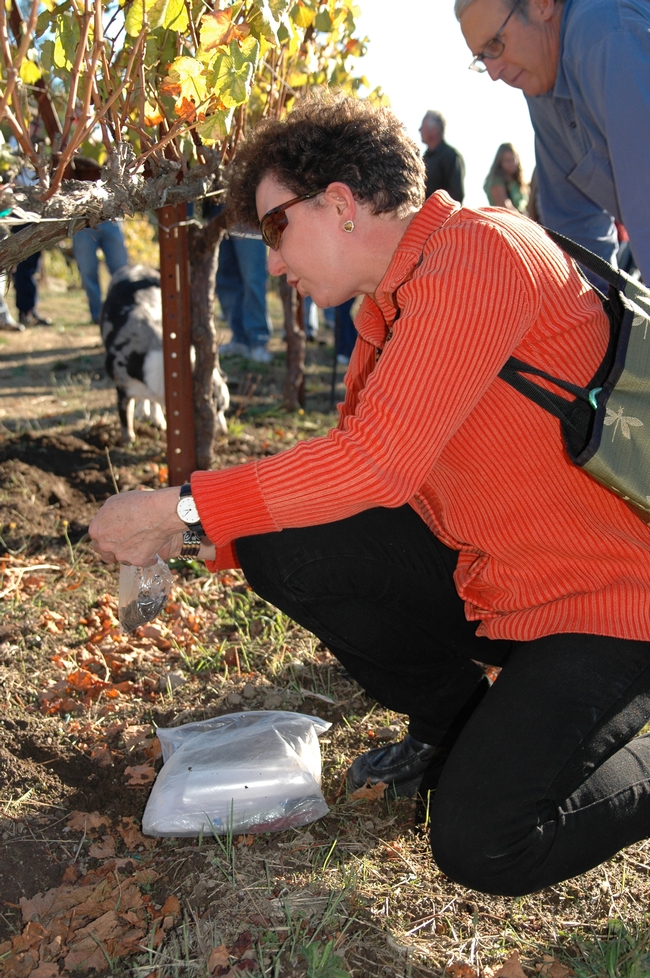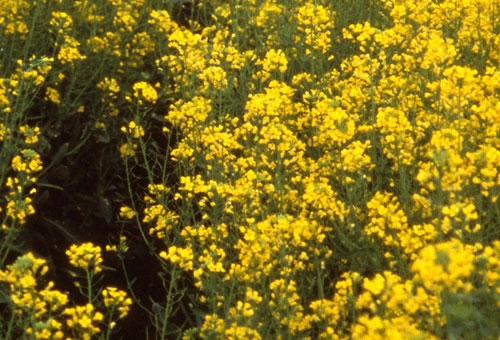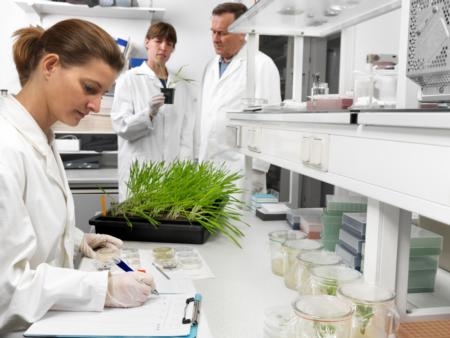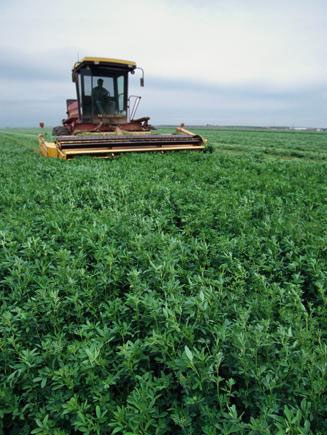Posts Tagged: biotechnology
How Pamela Marrone Does It
With the global population growing from 7 to 10 billion by 2050, there is an intense debate about how to best feed the world. With that, Pamela...

Pamela Marrone is an international expert in agricultural biotechnology and bioscience.
Software has the Silicon Valley, but ag technology isn't centered in one place
“With a state a thousand miles long and ecosystems ranging from rain forests to arid deserts, and cropping patterns affiliated with all those things, you will not find a single location to do what needs to be done,” said Don Klingborg, who directs the advocacy and county partnerships effort at the University of California Division of Agriculture and Natural Resources.
That’s why the university has nine extension centers across the state — someone needs to make sure that the ideas that come out of campus labs will actually work in the field, the article noted.
“Once it has gone through that and you have done the fine-tuning, then it is time to do the transfer into the private sector,” Klingborg said.
A new generation of farmers emerges
Linda DuBois, Comstock
There are a significant number of younger Californians very interested in food, and that leads them to an interest in agriculture, said UC Davis professor Tom Tomich, director of the UC's Agriculture Sustainability Institute and of the statewide UC Sustainable Agriculture Research and Education Program.
To meet this demand, UC Davis launched a new bachelor’s degree program in sustainable agriculture and food systems.
“There’s a real emphasis on experiential learning because so many of the students don’t come from a farm background,” Tomich says.
Nurturing a new crop of farmers is imperative because California agriculture is crucial to the state’s economy and to the nation’s food security, says Craig McNamara, president of the California Board of Food and Agriculture.
Can GE and non-GE alfalfas co-exist?
Those of us who work with alfalfa have seen our much-loved Queen of Forages relegated to poster child of all things evil about genetic engineering (GE) and the supposed damage it may wreak. While hay growers have always felt alfalfa has received insufficient attention – this was probably not what they had in mind!
I’m referring, of course, to the release of Roundup Ready alfalfa (RRA) in 2005 and the subsequent lawsuit that stopped its planting from 2007 until 2011 – a case that went all the way to the Supreme Court!
The drama continues today with newly minted lawsuits, as farmers once again plant RRA and conventional alfalfa throughout the U.S. But what does this ballyhoo mean for those who actually grow alfalfa?
At the heart of the controversy is co-existence: whether cross-pollination from GE alfalfa would completely prevent organic or other growers who didn’t want GE alfalfa from practicing agriculture as they see fit. Or, alternatively, whether farmers can adopt methods to avoid undue neighbor influence or contamination.
Successful coexistence can be defined as the ability of diverse production systems (organic, GE-adopting, conventional) to thrive without excessive neighbor influence, or resorting to extraordinary protection measures.
Is co-existence possible? The answer is a definitive “yes” based on both history and principle. Agriculture is replete with examples of farmers adjusting and cooperating to make diverse systems work. In principle, there is no technical reason that diverse farming practices cannot co-exist.
So if you produce alfalfa for organic, export or other markets that don’t want GE crops, what is required? The answer is very different for those who grow alfalfa for hay vs. those who produce seed. Seed requires considerable isolation distances to prevent contamination – and always has.
For hay, a series of steps can reduce this risk to very low levels.
The first, and most important step is to plant seed tested and determined as non-GE. Plenty of conventional seed is available, as are inexpensive testing methods to assure that the seed is non-GE. Seed companies have committed to produce conventional seed in the future, including seed destined for GE-sensitive markets.
The next step is to assure that contamination doesn’t happen during harvest – through partial bales moving in balers from field to field or accidental misidentification of hay lots. This is likely the second-highest risk of contamination.
The lowest – but not zero – risk of contamination in hay: inadvertent gene flow from hayfield to hayfield.
Neighbors can reduce this risk further by: 1) Controlling unharvested plants on field edges and feral alfalfa along roadsides to prevent seed production; 2) Routinely harvesting hay to prevent excessive flowering; and 3) Completely removing crop before excessive flowering or seed production. Crop removal prevents permanent contamination, since seed must fall to the ground and grow into new plants to contaminate hayfields.
Lastly, it is important to understand thresholds or market tolerance.
Does a single RRA stem, accidently baled in a 200-ton lot of conventional hay (containing billions of stems), constitute contamination? This will be market-determined. Commercially available test strips will likely satisfy most if not all sensitive markets of a hay product’s non-GE status. All markets have thresholds for contaminants, and there is no reason to believe this to be an exception.
In short, methods are readily available to assure an alfalfa crop’s non-GE status, even as neighbors start growing GE alfalfa. These require a higher awareness of gene flow and other avenues of contamination, but do not appear to be onerous or difficult.
We also should not underestimate the importance of mutual respect and willingness to cooperate among parties as keys to a co-existence strategy. It is axiomatic that coexistence is impossible if parties are unwilling to listen to each other, allow a diversity of viewpoints or develop a way to resolve disputes.
The alfalfa industry has largely stepped forward to support diverse systems within the agricultural landscape and needs to continue to do so. This has been the case with National Alfalfa & Forage Alliance efforts to promote coexistence over the past 5 years, which continue today (see their website). Seed companies and growers continue to negotiate isolation distances for production of GE and non-GE seed. Likewise, hay farmers have demonstrated co-existence by growing RRA and organic alfalfa successfully on the same farms.
This year in California’s Imperial Valley, seed, hay and organic growers, exporters and seed companies have met extensively and decided to prohibit RRA in their region due to the close proximity of seed, hay, biological factors and the importance of seed and hay exports.
These are examples of “bottom-up” co-existence approaches led largely by farmers and companies – in contrast to regulations decided in Washington or through the courts.
The concept of right-to-farm and co-existence between neighbors and diverse industries is not new to agriculture. Yet the introduction of GE alfalfa and its potential influence on neighboring farmers requires improved co-existence strategies for alfalfa.
(This article was first printed in Hay and Forage Grower magazine.)
UC scientist tries to refute 'woo woo pseudoscience'
UC Davis plant pathologist Pamela Ronald appeared on the Dr. Oz television show, in which the medical personality promised to tell his audience what they need to know about GMOs.
Ronald was one of three guests, and the only one to support the production and consumption of genetically modified food.
"It was a tough go," Ronald wrote in a Tomorrow's Table blog post about her television appearance. "I did my best to refute the worst 'woo woo pseudoscience,' but it was difficult."
She pointed out on the program that, after 14 years of GMO consumption - primarily in food ingredients made from canola, soy beans, sugar beets and corn - there has been not a single instance of harm to human health or the environment.
However, Ronald's point was countered on the program by Jeffrey Smith, an anti-GMO activist, who said GE crops cause infertility, organ damage and endocrine disruption. Ronald said Smith's information doesn't have a scientific basis.
"We need to make policy based on the best science," Ronald said. "I would go with scientific information rather than ideas that have been put forth by non scientists."
Ronald referred viewers to three websites that she said contain science-based information about GMOs:
GM canola growing wild in North Dakota
Canola that is genetically modified to be resistant to two herbicides is growing along roadsides in North Dakota, according to a New York Times blog post by Andrew Pollack.Even though critics of biotech crops point to the situation as "gene pollution," Pollack said the finding may not be a problem at all. And if it is a problem, he wrote, "It’s because a canola plant growing outside of a canola field – on a road or in a field of wheat, for example – could be considered a weed."
The study, presented at a recent meeting of the Ecological Society of America, is based on a sampling of 604 canola plants collected by a University of Arkansas graduate study along 3,000 miles of interstate, state and county roads. Eighty percent were genetically engineered.
In a statement, Monsanto, the manufacturer GM canola, said roadside canola can be managed simply by mowing.
"Monsanto provides farmers and other professionals who use our products information on managing plants like volunteer canola,” the statement said.
Pollock turned to UC Riverside professor of genetics Norman Ellstrand to find out why genetically modified corn and soybeans have not established themselves in the wild, even though they are grown on many more acres than canola.
“They are super-domesticated and they just don’t really like to go wild,’’ Ellstrand was quoted.

Feral canola is growing on North Dakota roadsides.



